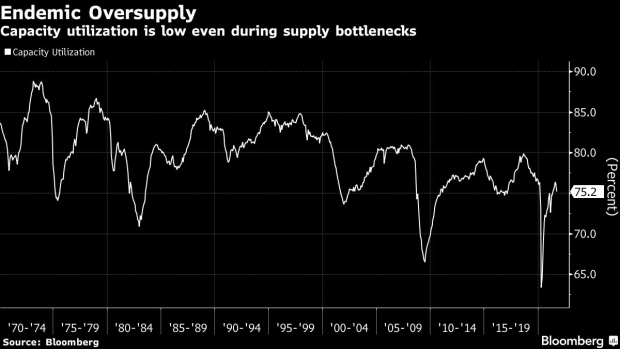Nov 12, 2021
Consumer Anger About Inflation Can Make a 1970s Rerun Real
, Bloomberg News

(Bloomberg) -- The last U.S. CPI report was a doozy, with inflation coming in at the highest in three decades. But Friday’s University of Michigan Consumer Sentiment Survey is equally worrying for what it says about inflation’s impact on the economy.
It isn’t clear how central banks should respond since supply-side issues are “artificial” constraints imposed by the pandemic. Capacity utilization remains depressed, suggesting that once the pandemic fades, disinflation, or outright deflation, will re-emerge. But consumer sentiment is at the lowest in 10 years because of inflation. And that matters.
If we look at a long run chart of U.S. capacity utilization, it’s clear that there has been a long-term trend toward increasing oversupply.
Arguably, low capacity utilization helped entrench disinflation over the past forty years. Even now, excess capacity should exert downward pressure on price levels.
But supply chains have become stretched as consumers have re-allocated consumption during the pandemic and as manufacturing hubs have faced shutdowns and stoppages due to coronavirus outbreaks.
Raising rates to combat inflation is mostly about curbing demand by reducing money-supply growth via making borrowing more expensive. That works with a considerable lag. The bottlenecks could be over before the policy shift kicks in. It’s clear central bankers feel acting now could backfire once supply constraints are removed. So they have sat on their hands as inflation has spiked.
Consumers are reaching a breaking point. Today’s University of Michigan Consumer Sentiment Index release came in below expectations in large part because of inflation. Earlier, Bloomberg’s Brian Chappatta pointed out that the numbers show that “1 in 4 consumers cited inflationary reductions in their living standards in November, with lower income and older consumers voicing the greatest impact.” As renting, filling up the tank and buying food to put on the table become more expensive, consumers lose the ability to make discretionary purchases. If central banks are concerned about expectations feeding an inflationary spiral, they have to act before demand destruction kicks in.
This situation may not be like the 1970s when capacity utilization almost hit 90%. But with supply-chain bottlenecks likely to persist, it is close enough that the loss of earnings power and the anger about inflation have become a rising threat to the economy.
This was a post on Bloomberg’s Markets Live blog. The observations are those of the blogger and not intended as investment advice. For more markets analysis, go to MLIV.
©2021 Bloomberg L.P.